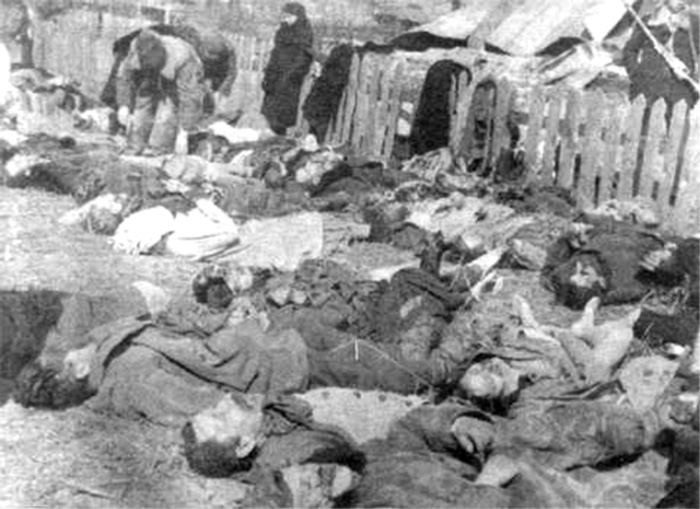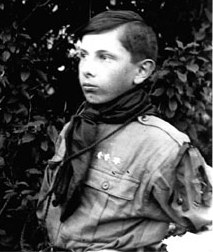|
OUN-UPA
The Ukrainian Insurgent Army ( uk, Українська повстанська армія, УПА, translit=Ukrayins'ka povstans'ka armiia, abbreviated UPA) was a Ukrainian nationalist paramilitary and later partisan formation. During World War II, it was engaged in guerrilla warfare against the Soviet Union, the Polish Underground State, Communist Poland, and Nazi Germany. It was established by the Organization of Ukrainian Nationalists. The insurgent army arose out of separate militant formations of the Organization of Ukrainian Nationalists—Bandera faction (the OUN-B), other militant national-patriotic formations, some former defectors of the Ukrainian Auxiliary Police, mobilization of local populations and others.Vedeneyev, D. Military Field Gendarmerie – special body of the Ukrainian Insurgent Army'. "Voyenna Istoriya" magazine. 2002. The political leadership of the army belonged to the OUN-B. It was the primary perpetrator of the ethnic cleansing of Poles in Volh ... [...More Info...] [...Related Items...] OR: [Wikipedia] [Google] [Baidu] |
Massacres Of Poles In Volhynia And Eastern Galicia
The massacres of Poles in Volhynia and Eastern Galicia ( pl, rzeź wołyńska, lit=Volhynian slaughter; uk, Волинська трагедія, lit=Volyn tragedy, translit=Volynska trahediia), were carried out in German-occupied Poland by the Ukrainian Insurgent Army, or the UPA, with the support of parts of the local Ukrainian population against the Polish minority in Volhynia, Eastern Galicia, parts of Polesia and Lublin region from 1943 to 1945. The peak of the massacres took place in July and August 1943. Most of the victims were women and children. Many of the Polish victims regardless of age or gender were tortured before being killed; some of the methods included rape, dismemberment or immolation, among others. The UPA's actions resulted in between 50,000 and 100,000 deaths. According to Timothy Snyder, the ethnic cleansing was a Ukrainian attempt to prevent the post-war Polish state from asserting its sovereignty over Ukrainian-majority areas that had been part of th ... [...More Info...] [...Related Items...] OR: [Wikipedia] [Google] [Baidu] |
Organization Of Ukrainian Nationalists
The Organization of Ukrainian Nationalists ( uk, Організація українських націоналістів, Orhanizatsiya ukrayins'kykh natsionalistiv, abbreviated OUN) was a Ukrainian ultranationalist political organization established in 1929 in Vienna. The OUN was the largest and one of the most important far-right Ukrainian organizations operating in the Kresy region (Eastern Galicia) of the Second Polish Republic. OUN emerged as a union between the Ukrainian Military Organization, smaller radical right-wing groups, and right-wing Ukrainian nationalists and intellectuals represented by Dmytro Dontsov, Yevhen Konovalets, Mykola Stsiborskyi, and other figures. The ideology of the OUN has been described as similar to Italian Fascism. The OUN sought to infiltrate legal political parties, universities and other political structures and institutions. The OUN's strategies to achieve Ukrainian independence included violence and terrorism against perceived foreign a ... [...More Info...] [...Related Items...] OR: [Wikipedia] [Google] [Baidu] |
Roman Shukhevych
Roman-Taras Yosypovych Shukhevych ( uk, Рома́н-Тарас Йо́сипович Шухе́вич, also known by his pseudonym, Tur and Taras Chuprynka; 30 June 1907 – 5 March 1950), was a Ukrainian nationalist, one of the commanders of Nachtigall Battalion, a of the German Schutzmannschaft 201 auxiliary police battalion, a military leader of the Ukrainian Insurgent Army (UPA), and one of the perpetrators of the Galicia-Volhynia massacres of approximately 100,000 Poles. Life Shukhevych was born in the city of Lviv,Kentiy, A"Roman Shukhevych" ''Encyclopedia of History of Ukraine''. 2013 in the Kingdom of Galicia and Lodomeria (some sources claim his place of birth as Krakovets). Both Shukhevych's parents were involved with the Ukrainian national revival in the 19th century. The family lays claim to dozens of active community activists in politics, music, science, and art. Shukhevych received his early education outside of Lviv. He returned to Lviv to study at the Lviv Ac ... [...More Info...] [...Related Items...] OR: [Wikipedia] [Google] [Baidu] |
Stepan Bandera
Stepan Andriyovych Bandera ( uk, Степа́н Андрі́йович Банде́ра, Stepán Andríyovych Bandéra, ; pl, Stepan Andrijowycz Bandera; 1 January 1909 – 15 October 1959) was a Ukrainian far-right leader of the radical, terrorist wing of the Organization of Ukrainian Nationalists named OUN-B. Bandera was born in the Austro-Hungarian Empire, in Galicia, into the family of a priest of the Ukrainian Greek Catholic Church. Involved in nationalist organizations from a young age, Bandera was sentenced to death for his involvement in the 1934 assassination of Poland's Minister of the Interior Bronisław Pieracki, commuted to life imprisonment. Freed from prison in 1939 following the invasion of Poland, Bandera prepared the 30 June 1941 Proclamation of Ukrainian statehood in Lviv, pledging to work with Germany after Germany invaded the Soviet Union on 22 June 1941. The Germans disapproved the proclamation and for his refusal to rescind the decree, Bandera was a ... [...More Info...] [...Related Items...] OR: [Wikipedia] [Google] [Baidu] |
Ukrainian Auxiliary Police
The ''Ukrainische Hilfspolizei'' or the Ukrainian Auxiliary Police ( ua, Українська допоміжна поліція, Ukrains'ka dopomizhna politsiia) was the official title of the local police formation (a type of hilfspolizei) set up by Nazi Germany during World War II in ''Reichskommissariat Ukraine'', shortly after the German conquest of the Ukrainian Soviet Socialist Republic in Operation Barbarossa against the Soviet Union, Germany's former co-belligerent in the invasion of Poland. The Ukrainian Auxiliary Police was created by Heinrich Himmler in mid-August 1941 and put under the control of German ''Ordnungspolizei'' in General Government territory. The actual ''Reichskommissariat Ukraine'' was formed officially on 20 August 1941.Jürgen Matthäus, Jewish Responses to Persecution: 1941–1942.' AltaMira Press, p. 524. The uniformed force was composed in large part of the former members of the Ukrainian People's Militia created by OUN in June. There were two categor ... [...More Info...] [...Related Items...] OR: [Wikipedia] [Google] [Baidu] |
Nazi Germany
Nazi Germany (lit. "National Socialist State"), ' (lit. "Nazi State") for short; also ' (lit. "National Socialist Germany") (officially known as the German Reich from 1933 until 1943, and the Greater German Reich from 1943 to 1945) was the German state between 1933 and 1945, when Adolf Hitler and the Nazi Party controlled the country, transforming it into a dictatorship. Under Hitler's rule, Germany quickly became a totalitarian state where nearly all aspects of life were controlled by the government. The Third Reich, meaning "Third Realm" or "Third Empire", alluded to the Nazi claim that Nazi Germany was the successor to the earlier Holy Roman Empire (800–1806) and German Empire (1871–1918). The Third Reich, which Hitler and the Nazis referred to as the Thousand-Year Reich, ended in May 1945 after just 12 years when the Allies defeated Germany, ending World War II in Europe. On 30 January 1933, Hitler was appointed chancellor of Germany, the head of gove ... [...More Info...] [...Related Items...] OR: [Wikipedia] [Google] [Baidu] |
Communist Poland
The Polish People's Republic ( pl, Polska Rzeczpospolita Ludowa, PRL) was a country in Central Europe that existed from 1947 to 1989 as the predecessor of the modern Republic of Poland. With a population of approximately 37.9 million near the end of its existence, it was the second-most populous communist and Eastern Bloc country in Europe. It was also one of the main signatories of the Warsaw Pact alliance. The largest city and official capital since 1947 was Warsaw, followed by the industrial city of Łódź and cultural city of Kraków. The country was bordered by the Baltic Sea to the north, the Soviet Union to the east, Czechoslovakia to the south, and East Germany to the west. The Polish People's Republic was a socialist one-party state, with a unitary Marxist–Leninist government headed by the Polish United Workers' Party (PZPR). The country's official name was the "Republic of Poland" (') between 1947 and 1952 in accordance with the transitional Small Constitut ... [...More Info...] [...Related Items...] OR: [Wikipedia] [Google] [Baidu] |
Polish Underground State
The Polish Underground State ( pl, Polskie Państwo Podziemne, also known as the Polish Secret State) was a single political and military entity formed by the union of resistance organizations in occupied Poland that were loyal to the Government of the Republic of Poland in exile in London. The first elements of the Underground State were established in the final days of the German and Soviet invasion of Poland, in late September 1939. The Underground State was perceived by supporters as a legal continuation of the pre-war Republic of Poland (and its institutions) that waged an armed struggle against the country's occupying powers: Nazi Germany and the Soviet Union. The Underground State encompassed not only military resistance, one of the largest in the world, but also civilian structures, such as justice, education, culture and social services. Although the Underground State enjoyed broad support throughout much of the war, it was not supported or recognized by the far ... [...More Info...] [...Related Items...] OR: [Wikipedia] [Google] [Baidu] |
Soviet Union
The Soviet Union,. officially the Union of Soviet Socialist Republics. (USSR),. was a transcontinental country that spanned much of Eurasia from 1922 to 1991. A flagship communist state, it was nominally a federal union of fifteen national republics; in practice, both its government and its economy were highly centralized until its final years. It was a one-party state governed by the Communist Party of the Soviet Union, with the city of Moscow serving as its capital as well as that of its largest and most populous republic: the Russian SFSR. Other major cities included Leningrad (Russian SFSR), Kiev (Ukrainian SSR), Minsk ( Byelorussian SSR), Tashkent (Uzbek SSR), Alma-Ata (Kazakh SSR), and Novosibirsk (Russian SFSR). It was the largest country in the world, covering over and spanning eleven time zones. The country's roots lay in the October Revolution of 1917, when the Bolsheviks, under the leadership of Vladimir Lenin, overthrew the Russian Provisional Government ... [...More Info...] [...Related Items...] OR: [Wikipedia] [Google] [Baidu] |
Partisans (military)
A partisan is a member of an irregular military force formed to oppose control of an area by a foreign power or by an army of military occupation, occupation by some kind of insurgent activity. The term can apply to the field element of resistance movements. The most common use in present parlance in several languages refers to Resistance during World War II, occupation resistance fighters during World War II, especially under the Yugoslav Partisans, Yugoslav partisan leader Josip Broz Tito. History before 1939 The initial concept of partisan warfare involved the use of militia , troops raised from the local population in a war zone (or in some cases regular forces) who would operate behind enemy front line , lines to disrupt communications, seize posts or villages as forward-operating bases, ambush convoys, impose war taxes or contributions, raid logistical stockpiles, and compel enemy forces to disperse and protect their base of operations. George Satterfield has analyse ... [...More Info...] [...Related Items...] OR: [Wikipedia] [Google] [Baidu] |
Paramilitary
A paramilitary is an organization whose structure, tactics, training, subculture, and (often) function are similar to those of a professional military, but is not part of a country's official or legitimate armed forces. Paramilitary units carry out duties that a country's military or police forces are unable or unwilling to handle. Other organizations may be considered paramilitaries by structure alone, despite being unarmed or lacking a combat role. Overview Though a paramilitary is, by definition, not a military, it is usually equivalent to a light infantry force in terms of strength, firepower, and organizational structure. Paramilitaries use "military" equipment (such as long guns and armored personnel carriers; usually military surplus resources), skills (such as battlefield medicine and bomb disposal), and tactics (such as urban warfare and close-quarters combat) that are compatible with their purpose, often combining them with skills from other relevant fields such a ... [...More Info...] [...Related Items...] OR: [Wikipedia] [Google] [Baidu] |



.png)


